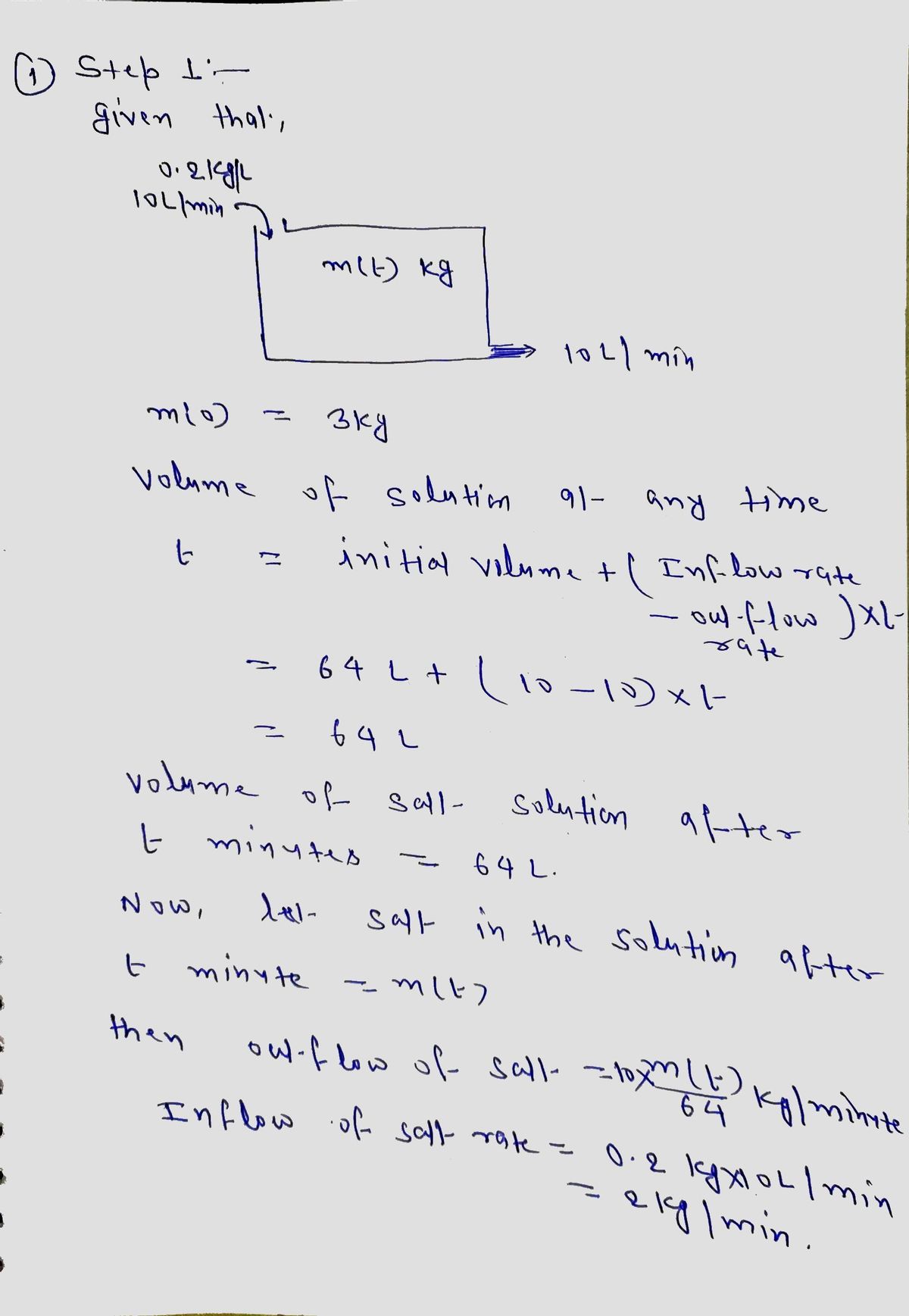1.10 Exercises 1. Determine the amount of salt in the tank, and the concentration of the solution after 9 minutes for the mixing problem described in this section, except the stirred mixture is drained off at the rate of 10 L/min.
1.10 Exercises 1. Determine the amount of salt in the tank, and the concentration of the solution after 9 minutes for the mixing problem described in this section, except the stirred mixture is drained off at the rate of 10 L/min.
Advanced Engineering Mathematics
10th Edition
ISBN:9780470458365
Author:Erwin Kreyszig
Publisher:Erwin Kreyszig
Chapter2: Second-order Linear Odes
Section: Chapter Questions
Problem 1RQ
Related questions
Question
Problem 1 please

Transcribed Image Text:Let us consider the following problem. Suppose that a tank contains 64 L of
water in which 3 kg of salt is dissolved. At a certain instant, a salt solution
with a concentration of 0.2 kg/L begins to flow into the tank at the rate of 10
L/min, and simultaneously the stirred mixture is drained off at the rate of 6
L/min. After 9 minutes, what is the amount of salt in the tank, and what is
the concentration of the solution?
0.2 kg/L
10 U/min
dm
dt
C(t) =
100
m(t) kg
4(t+16) L
m(t)
v(t)
(4) 10
Figure A
Three functions can be introduced here. The first is the volume v(t) (mea-
sured in L) of the solution in the tank at time t (min). Obviously
v(t) = 64(L) + (106) (L/min) x t(min) = 4(t+16) (L).
The second is the amount of salt (in kg) in the tank at time t, and we denote
this function by m(t). The third is the concentration C(t) of salt in the tank at
time t, and
(kg/min) = 0.2(kg/L) x 10(L/min)
dm
dt
6 U/min
m(t)
4(t+16)
+
m(t)
4(t+16)
Thus, when we find m(t), we will also know C(t).
The rate of change of m(t) is the difference between the rate in and the rate
out:
-(kg/L).
kg/L
m(t)
4(t + 16)
3m
2(t+16)
The initial condition for this first-order linear differential equation is
m(0) = 3.
= 2.
(kg/L) x 6(L/min), or
(2)

Transcribed Image Text:To solve (1), we first solve the corresponding homogeneous differential equation
3m
2(t+16)
from which we find that
dm
m
In m
Then
m
Hence
=
dm
dt
+
3dt
2(t+16)
Substituting it into (1) we get
Now we will look for the solution of (1) in the form
m = c(t) (t+16)-3/2
+C1,
3
-In(t+16) + C₁ = ln(t+16)-3/2 + C1,
e(t+16)-3/2 = c(t+16)-3/2
= 0,
c' (t) = 2(t+16) ³/2,
c'(t) (t+16)-3/2(t+16)-5/² c(t) + 3c(t) (t+16)-3/2
2(t+16)
c(t) = 0.8 (t+16) 5/2 + k.
= 2.
gard T
liv
t
m(t) = 0.8(t+16) + k(t+16)-3/2
Substituting t = 0, we find from the initial condition (2) that
3= 0.8 x 16+kx 16-3/2, or k=-627.2.
Thus the mass and the concentration of salt in the tank are un bw new aunT
net losing of T
m(t) = 0.8 (t+16) - 627.2(t+16)-3/2 and C(t) = 0.2-156.8 (t+16)-5
-5/2
JO
In particular, m(9) = 15 (kg), C(9) = 0.15 (kg/L). Note that as t increases
(assuming that the tank does not overflow) the concentration C(t) approaches
0.2 (kg/L), the concentration of the incoming solution.
1.10 Exercises
1. Determine the amount of salt in the tank, and the concentration of the
solution after 9 minutes for the mixing problem described in this section,
except the stirred mixture is drained off at the rate of 10 L/min.
Expert Solution
Step 1

Step by step
Solved in 3 steps with 3 images

Recommended textbooks for you

Advanced Engineering Mathematics
Advanced Math
ISBN:
9780470458365
Author:
Erwin Kreyszig
Publisher:
Wiley, John & Sons, Incorporated

Numerical Methods for Engineers
Advanced Math
ISBN:
9780073397924
Author:
Steven C. Chapra Dr., Raymond P. Canale
Publisher:
McGraw-Hill Education

Introductory Mathematics for Engineering Applicat…
Advanced Math
ISBN:
9781118141809
Author:
Nathan Klingbeil
Publisher:
WILEY

Advanced Engineering Mathematics
Advanced Math
ISBN:
9780470458365
Author:
Erwin Kreyszig
Publisher:
Wiley, John & Sons, Incorporated

Numerical Methods for Engineers
Advanced Math
ISBN:
9780073397924
Author:
Steven C. Chapra Dr., Raymond P. Canale
Publisher:
McGraw-Hill Education

Introductory Mathematics for Engineering Applicat…
Advanced Math
ISBN:
9781118141809
Author:
Nathan Klingbeil
Publisher:
WILEY

Mathematics For Machine Technology
Advanced Math
ISBN:
9781337798310
Author:
Peterson, John.
Publisher:
Cengage Learning,

